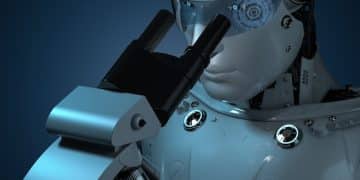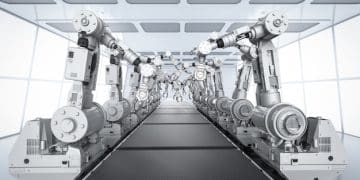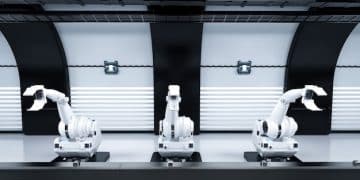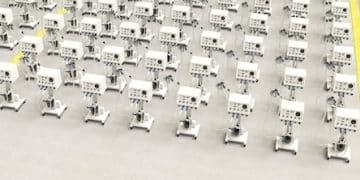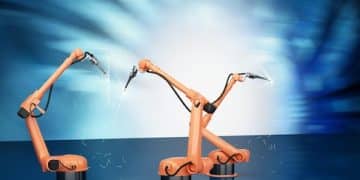Robotics in US Healthcare: Improving Care & Cutting Costs by 10%
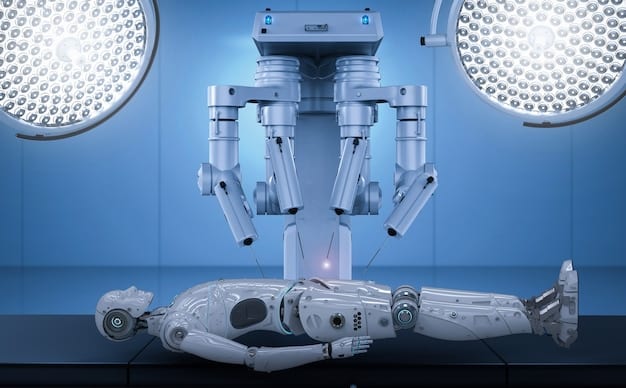
The integration of robotics in US healthcare is demonstrably enhancing patient care and reducing operational costs, with some projections indicating a potential 10% decrease in expenses across various medical applications.
In a rapidly evolving global healthcare landscape, the United States is increasingly turning to advanced technological solutions to address complex challenges. Among these innovations, robotics in US healthcare: how robots are improving patient care and reducing costs by 10% stands out as a transformative force, promising not only to elevate the quality of patient care but also to deliver significant financial efficiencies. This paradigm shift, from surgical precision to logistical automation, is redefining the therapeutic journey and operational effectiveness within hospitals and clinics nationwide.
The Robotic Revolution in Modern Medicine
The dawn of the 21st century has seen an unprecedented acceleration in the adoption of robotic technologies across various sectors, and healthcare is no exception. This revolution is driven by the inherent capabilities of robots to perform tasks with precision, consistency, and tireless efficiency, attributes that are critically valuable in a field where human error can have dire consequences. From complex surgical procedures to the mundane yet vital tasks of delivery and disinfection, robots are carving out indispensable roles within the US healthcare system.
The initial skepticism surrounding the integration of machines into such a human-centric domain has largely given way to recognition of their profound benefits. While robots will never fully replace the human touch and empathy vital to patient care, they are proving to be powerful allies, extending the capabilities of medical professionals and freeing them to focus on aspects that truly require human judgment and interaction.
Enhanced Surgical Precision and Outcomes
Surgical robots, such as the da Vinci Surgical System, have become emblematic of this technological leap. These systems allow surgeons to perform minimally invasive procedures with unparalleled accuracy, often leading to better patient outcomes, reduced recovery times, and less post-operative pain. The magnified 3D visualization and wristed instruments move with a greater range of motion than the human hand, translating to intricate maneuvers within confined spaces.
- Minimal blood loss during surgery.
- Faster patient recovery and discharge.
- Reduced risk of infection and complications.
- Improved precision in delicate procedures.
The adoption of these systems is not merely a novelty; it is a strategic investment that yields tangible clinical and economic benefits. While the initial capital outlay can be substantial, the long-term savings from shorter hospital stays and fewer complications contribute significantly to cost reduction.
Automating Repetitive and Risky Tasks
Beyond the operating room, robots are proving invaluable in automating a myriad of repetitive, time-consuming, or hazardous tasks. This includes the transportation of medications, lab samples, and sterile supplies, as well as the cleaning and disinfection of hospital environments. Autonomous mobile robots (AMRs) navigate hospital corridors, ensuring that vital resources are delivered promptly and safely, reducing the strain on human staff and minimizing potential contamination pathways.
These automated systems liberate nurses and other medical personnel from logistical duties, allowing them to dedicate more time to direct patient care—a crucial factor in improving patient satisfaction and clinical quality. Furthermore, the meticulousness of robotic disinfection systems offers a new layer of protection against healthcare-associated infections (HAIs), a persistent and costly challenge for hospitals.
In essence, the robotic revolution in modern medicine is multi-faceted, touching upon virtually every aspect of healthcare delivery. It is a testament to human ingenuity, leveraging technology to address perennial challenges, enhance efficiency, and ultimately, elevate the standard of care for millions.
Cost Reduction Strategies: How Robotics Drives Efficiency
One of the most compelling arguments for integrating robotics into healthcare is their potential to significantly reduce operational costs. While the initial investment in robotic technology can be substantial, the long-term savings generated through increased efficiency, reduced errors, and optimized resource utilization often far outweigh the upfront expenditures. The promise of a 10% reduction in costs is not merely aspirational but is being increasingly realized across various facets of the US healthcare system.
This cost-saving potential is particularly critical in a healthcare environment grappling with escalating expenses, aging populations, and persistent staffing shortages. Robots offer a tangible solution to these pressures by streamlining workflows and enhancing productivity.
Optimizing Staff Utilization and Reducing Labor Costs
Labor costs represent a significant portion of healthcare expenditures. Robots help mitigate these costs by assuming tasks that are either highly repetitive, physically demanding, or require constant monitoring. This includes tasks like transporting linens, meals, and medical supplies, or even assisting in patient rehabilitation.
- Reduces the need for staff to perform menial tasks, freeing them for higher-value activities.
- Decreases overtime pay by improving overall efficiency.
- Mitigates staff burnout and improves job satisfaction by delegating less desirable duties.
- Addresses staffing shortages by augmenting existing human resources.
By optimizing staff utilization, healthcare facilities can either reduce their reliance on temporary staffing agencies, which often come at a premium, or reallocate existing staff to areas where the human element is truly indispensable, such as direct patient interaction, complex decision-making, and emotional support.
Decreased Hospital Readmissions and Complications
Robotic precision in surgery and other procedures often leads to better patient outcomes, which directly translates to reduced healthcare costs. Fewer complications mean less need for follow-up interventions, shorter hospital stays, and decreased readmission rates. Hospital readmissions are a major financial burden for healthcare systems, often resulting in penalties from payers and consuming valuable bed space.
For instance, robot-assisted surgeries, by being less invasive, tend to minimize surgical trauma, leading to quicker healing and a lower incidence of post-operative complications like infections. Every avoided complication or readmission represents substantial savings in terms of resources, staff time, and medication usage.
Improved Inventory Management and Resource Allocation
Autonomous mobile robots (AMRs) are instrumental in automating the transport of pharmaceuticals, lab samples, and other critical supplies within a hospital. This not only ensures timely delivery but also leads to more accurate inventory management, reducing waste and preventing stockouts or overstocking. Precise tracking of medications and supplies minimizes losses and ensures optimal use of resources.
By integrating with hospital information systems, these robots can help maintain optimal stock levels, alert staff to low supplies, and even manage expiration dates, thereby reducing spoilage and unnecessary expenditures. This level of logistical efficiency is difficult to achieve with manual processes alone, making robotics a valuable asset in optimizing resource allocation and driving down overall operational costs in healthcare facilities.
Improving Patient Care: Beyond Efficiency
While the economic benefits of robotics in healthcare are compelling, their impact on patient care extends far beyond mere efficiency and cost reduction. The integration of robots is fundamentally transforming the patient experience, leading to safer, more personalized, and often more comfortable care. This evolution of care delivery highlights how technology can serve humanity by enhancing the core mission of medicine.
The direct benefits to patients are manifold, ranging from improved diagnostic accuracy to enhanced personal comfort, signaling a new era in which technological prowess directly contributes to human well-being.
Enhanced Safety and Reduced Infection Risks
In environments where precision and sterility are paramount, robots offer an undeniable advantage. Surgical robots filter out natural human tremor, ensuring a steadier hand during delicate procedures. Furthermore, robots dedicated to sanitation provide a level of thoroughness in cleaning and disinfection that is difficult to replicate with manual methods, significantly reducing the risk of healthcare-associated infections (HAIs).
Ultraviolet (UV-C) light disinfection robots, for example, can systematically sterilize patient rooms and operating theaters, reaching surfaces that might be missed by traditional cleaning. This proactive approach to infection control protects not only patients but also healthcare workers, creating a safer environment for everyone.
- Superior precision minimizes surgical errors.
- Automated disinfection reduces germ transmission.
- Consistent application of hygiene protocols.
- Fewer human-to-surface contacts lowering contamination.
The ability of robots to perform these critical tasks consistently and without fatigue reduces a significant vector for patient harm, reinforcing trust in medical facilities and improving overall public health outcomes.
Personalized Rehabilitation and Therapy
Robots are playing an increasingly vital role in rehabilitation and physical therapy, offering highly personalized and consistent treatment. Exoskeletons and robotic therapy devices can assist patients in regaining motor function after strokes, injuries, or neurological conditions. These devices can tailor exercises to an individual’s specific needs, track progress with precision, and provide objective data for clinicians.
The consistent, repetitive nature of robotic-assisted therapy can lead to faster and more complete recovery pathways than traditional methods alone. For patients, this means a more engaging and effective rehabilitation journey, often leading to greater independence and a higher quality of life post-recovery.
Improved Accessibility and Telemedicine Support
In a vast country like the US, access to specialized medical care can be a challenge, particularly in rural or underserved areas. Telepresence robots are bridging this gap, allowing specialists to consult with patients remotely, provide diagnoses, and even monitor vital signs from hundreds or thousands of miles away. This significantly improves accessibility to expert opinions and reduces the need for patients to travel long distances for appointments, saving them time and money.
These robots facilitate virtual rounds in hospitals, enabling doctors to check on patients without physically entering their rooms, which can be particularly useful in isolation wards or during infectious disease outbreaks. By expanding the reach of healthcare providers, robotics ensures that high-quality care is available to a wider segment of the population, democratizing medical services and making healthcare more inclusive.
Ultimately, the role of robotics in healthcare is not just about efficiency; it’s about fundamentally improving the patient experience. By enhancing safety, enabling personalized treatment, and expanding access to care, robots are helping to fulfill medicine’s promise of a healthier, more vibrant society.
Challenges and the Path Forward for Robotics Adoption
While the benefits of robotics in US healthcare are compelling and widely recognized, their widespread adoption is not without significant challenges. These hurdles encompass a range of issues from the substantial upfront costs and the complexity of integration to ethical considerations and the need for new regulatory frameworks. Addressing these challenges is crucial for realizing the full potential of robotic technology to transform healthcare.
Despite the obstacles, the trajectory for robotics in healthcare remains overwhelmingly positive, driven by continuous innovation and a growing imperative for efficient, high-quality care.
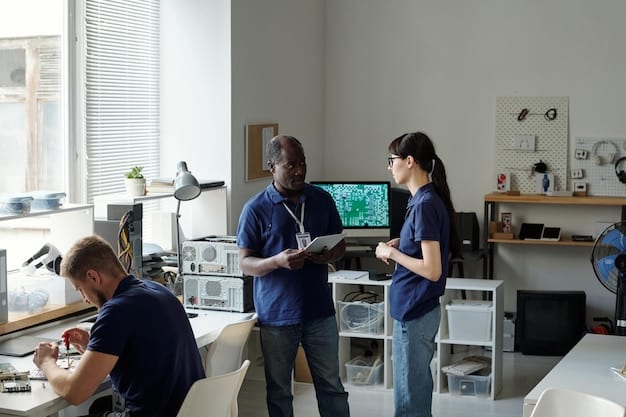
High Initial Investment and Maintenance Costs
The most significant barrier to entry for many healthcare facilities is the substantial capital investment required to purchase and install robotic systems. Advanced surgical robots, for instance, can cost millions of dollars, with additional expenses for maintenance, specialized instruments, and training for medical staff.
For smaller hospitals or those with limited budgets, these costs can be prohibitive, creating a disparity in access to cutting-edge technology. Manufacturers and policymakers are exploring various financial models, such as leasing options or government subsidies, to make these technologies more accessible.
Regulatory Complexity and Standardization
Integrating new robotic technologies into a highly regulated environment like healthcare introduces complex regulatory challenges. Ensuring the safety, efficacy, and interoperability of these devices requires rigorous testing and approval processes by bodies like the FDA. The rapid pace of technological innovation often outstrips the development of regulatory frameworks, leading to delays and uncertainty.
There is also a growing need for standardization in how robots communicate with existing hospital IT systems, electronic health records (EHRs), and other medical devices. A lack of interoperability can create silos of data and hinder seamless integration, undermining the potential benefits of automation.
Regulations must evolve to accommodate the unique characteristics of robotic systems, including their autonomous capabilities and potential for remote operation, while ensuring patient safety and data privacy.
Ethical Considerations and Job Displacement Concerns
The rise of robotics in healthcare also brings forth ethical deliberations and concerns about potential job displacement. While robots are designed to augment human capabilities rather than replace them entirely, some fear that automation could lead to a reduction in certain types of healthcare jobs, particularly those involving repetitive or logistical tasks.
Ethical questions also arise regarding accountability in cases of robotic malfunction or error. Who is responsible when a robot-assisted surgery goes awry—the surgeon, the manufacturer, or the software developer? These complex ethical dilemmas require careful consideration and the establishment of clear guidelines.
Addressing these challenges requires a multi-stakeholder approach involving technology developers, healthcare providers, policymakers, and ethicists. By collaborating, they can navigate the complexities of robotics adoption, ensuring that these powerful tools are deployed responsibly and equitably to the benefit of all.
The Impact on Healthcare Professionals: Collaboration, Not Replacement
A common misconception surrounding the integration of robotics in healthcare is that they are designed to replace human healthcare professionals. In reality, the role of robotics is predominantly one of augmentation and collaboration. Robots are tools that extend the capabilities of doctors, nurses, and other medical staff, enabling them to perform their duties with greater precision, efficiency, and safety. This synergistic relationship is reshaping the roles of healthcare workers, emphasizing specialized skills and patient-centric care.
The narrative is shifting from job displacement to job transformation, where professionals are upskilling to work alongside their robotic counterparts.
Reshaping Roles and Focusing on High-Value Tasks
By automating routine, high-volume, or physically demanding tasks, robots free up healthcare professionals to focus on activities that require critical thinking, complex decision-making, empathy, and direct patient interaction. For example, nurses can spend less time fetching supplies and more time at the patient’s bedside, providing comfort and personalized care.
- Frees up nurses for direct patient interaction.
- Allows surgeons to focus on complex decision-making.
- Reduces physical strain on staff from manual tasks.
- Enhances job satisfaction by eliminating repetitive duties.
This reallocation of effort not only improves the quality of care but also enhances job satisfaction for medical staff, reducing burnout and improving retention rates—a critical factor in a field often plagued by staffing shortages.
Enhanced Training and Skill Development
The advent of robotic technology necessitates new training and skill sets for healthcare professionals. Surgeons must learn to operate robotic systems, and nurses and technicians need to be proficient in managing and maintaining various types of medical robots, from disinfection bots to automated medication dispensers. This demand for new skills drives continuous professional development and fosters a culture of technological literacy within healthcare institutions.
Training programs often involve hands-on experience with simulators, allowing professionals to practice complex procedures in a safe, controlled environment before working with actual patients. This specialized training not only ensures competence but also instills confidence in utilizing these advanced tools.
Improving Work Environment and Safety
Robots can take on tasks that are hazardous or ergonomically challenging for humans, thereby improving the overall work environment and safety for healthcare professionals. For instance, robots can handle infectious materials, lift heavy patients, or perform tasks in environments contaminated with pathogens, reducing the risk of injury and exposure for staff members.
The reduction in physical strain and exposure to risks translates to fewer workplace injuries and a healthier, safer environment for healthcare workers. This commitment to staff well-being is increasingly important for attracting and retaining talent in the demanding healthcare sector.
Ultimately, the integration of robotics is not about replacing healthcare professionals but empowering them. By working in tandem with intelligent machines, medical staff can achieve new levels of precision, efficiency, and safety, allowing them to dedicate their expertise to the most critical aspects of patient care and human connection.
Future Outlook: Expanding Horizons and AI Integration
The trajectory for robotics in US healthcare is one of continuous advancement, with future developments poised to further revolutionize patient care and operational efficiency. The next chapter will likely be defined by increasingly sophisticated AI integration, enhanced autonomy, and a broader application of robotic systems across the entire healthcare continuum, from primary care to post-acute rehabilitation. This forward-looking perspective suggests an even more synergistic relationship between humans and machines.
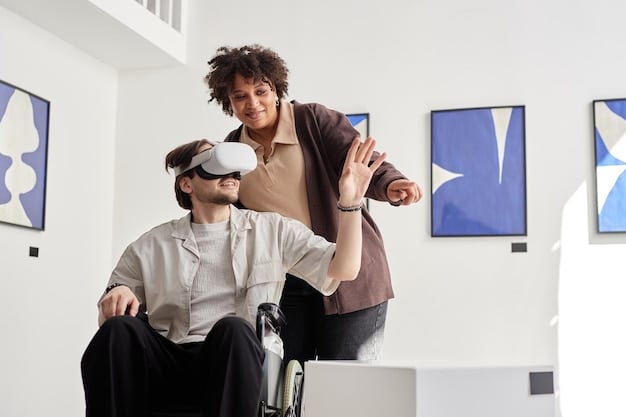
AI-Powered Robotic Systems
The true potential of robotics will be unlocked through deeper integration with artificial intelligence (AI). AI will enable robots to learn from data, adapt to new situations, and make more autonomous decisions, moving beyond programmed movements to intelligent behavior. This fusion will lead to diagnostic robots capable of analyzing complex medical images with greater accuracy than human eyes, or surgical robots that can autonomously identify anatomical structures and adjust their movements in real-time.
- Enhanced diagnostic accuracy through image analysis.
- Adaptive surgical assistance based on real-time data.
- Personalized treatment plans tailored by AI algorithms.
- Predictive analytics for patient deterioration.
AI will also power predictive analytics, identifying patents at risk of deterioration or readmission, allowing for proactive interventions. This level of intelligence will transform robots from mere tools into integral team members capable of sophisticated reasoning and problem-solving.
Miniaturization and Swarm Robotics
Future advancements will likely focus on miniaturization, leading to micro-robots capable of performing intricate tasks inside the human body. These tiny robots could deliver targeted drug therapies, perform minimally invasive diagnostic procedures, or even repair damaged tissues at a cellular level, heralding a new era of nanomedicine.
The concept of “swarm robotics,” where multiple small robots work collaboratively, could also find applications in healthcare, such as for large-scale disinfection of vast hospital areas or for complex, multi-site surgical interventions.
Robots in Home Healthcare and Eldercare
As the population ages, the demand for home healthcare and eldercare services is skyrocketing. Future robots will play an increasingly vital role in supporting independent living. Assistive robots could help elderly individuals with daily tasks like meal preparation, medication reminders, or even provide companionship and monitor their well-being, alerting caregivers in case of emergencies.
These robots could alleviate the burden on family caregivers and reduce the need for institutional care, allowing seniors to age in place with dignity and safety. This extension of robotics into the home environment represents a significant shift from clinical settings to broader societal applications, emphasizing wellness and continuous care.
The future of robotics in healthcare is bright, promising a landscape where technology and human expertise converge to deliver unprecedented levels of care, efficiency, and personalized attention. As research and development continue, the potential applications are limited only by imagination, driving healthcare towards a more automated, intelligent, and human-centered future.
| Key Area | Brief Impact Description |
|---|---|
| ➕ Patient Care | Enhances surgical precision, reduces infection risks, and improves rehabilitation outcomes. |
| 💸 Cost Reduction | Optimizes staff utilization, minimizes readmissions, and streamlines inventory management. |
| 🤝 Professional Role | Frees professionals for high-value tasks, requiring new skills and improving work safety. |
| 🚀 Future Trends | Integration with AI, miniaturization, and expansion into home healthcare. |
Frequently Asked Questions About Robotics in US Healthcare
▼
Robots enhance patient safety by performing tasks with extreme precision, such as in delicate surgeries, reducing human error. They also aid in thorough disinfection of hospital environments using UV-C light, significantly lowering the risk of healthcare-associated infections (HAIs) and creating cleaner, safer spaces for patients and staff.
▼
While a 10% cost reduction is an ambitious target, robotics contributes significantly to savings by optimizing staff utilization, which lessens labor costs. Furthermore, improved surgical outcomes reduce readmissions and complications, leading to shorter hospital stays and fewer follow-up procedures, all of which contribute to substantial financial efficiencies.
▼
Robots are largely augmenting, rather than replacing, human healthcare workers. They handle repetitive, dangerous, or physically demanding tasks, allowing medical professionals to focus on high-value activities like direct patient interaction, complex diagnoses, and empathetic care. This collaboration enhances efficiency and can improve job satisfaction for staff.
▼
The main types include surgical robots (for precision surgeries), autonomous mobile robots (AMRs) for logistics like delivering supplies, disinfection robots (for cleaning), and rehabilitation robots (for physical therapy). Emerging areas also include telepresence robots for remote consultations and assistive robots for eldercare in home settings.
▼
The future outlook involves deeper integration with Artificial Intelligence (AI) for enhanced autonomy and decision-making, leading to more precise diagnostics and personalized treatments. Expect advancements in miniaturization (micro-robots), swarm robotics, and a significant expansion into home healthcare and eldercare support to assist with daily living.
Conclusion
The integration of robotics into US healthcare represents a pivotal shift towards a more efficient, precise, and patient-centric medical landscape. From enhancing surgical outcomes and optimizing hospital logistics to potentially driving significant cost reductions, the benefits are clear. While challenges related to investment, regulation, and ethical considerations persist, the ongoing innovation and synergistic collaboration between human expertise and robotic capabilities promise a future where technology profoundly elevates the quality and accessibility of care for all Americans. The narrative is not one of replacement, but of empowerment, as robots free healthcare professionals to dedicate their invaluable skills to the most critical and human aspects of healing.

